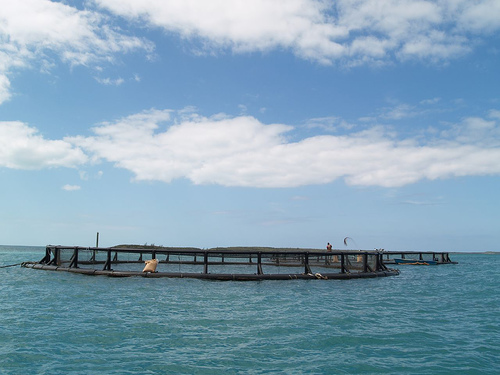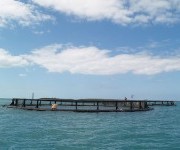
Offshore fish farms look tranquil above water, but a new Food & Water Watch report says that what happens below the surface is suspect.Photo: Simon Bradley
Consumer advocacy group Food & Water Watch (FWW) released a new report today criticizing the National Oceanic and Atmospheric Administration (NOAA) for its aquaculture policy, which they say is promoting factory fish farming in offshore waters. It also raises a red flag about the future of genetically modified fish such as AquaBounty’s AquAdvantage salmon — a particularly timely concern, given the recent news about its FDA approval.
Offshore aquaculture, is defined as fish farming done 3-200 miles offshore — in other words, outside of waters regulated by states.
The report comes after the agency released their final Marine Aquaculture Policy in June, which lays the U.S. framework for rules and regulations for all types of aquaculture.
More than half of the seafood consumed worldwide already comes from aquaculture. But domestic aquaculture provides only 5 percent of the seafood we consume; the rest of the farmed seafood we eat comes from parts of the world where there is little to no regulation. And, thanks to the 2010 federal dietary guidelines, which recommend Americans increase their seafood consumption twofold, the demand for farmed fish is likely to increase. But FWW’s report says building more fish farms offshore is not the answer. In fact, they believe doing so could have disastrous results.
“A leading argument used to promote factory fish farming is that we need it to offset the U.S. seafood trade deficit — that is, to import less seafood and produce more seafood,” says the report. But FWW points out that to counter that trade deficit, the U.S. would need to raise almost 200 million fish in ocean cages each year, using “41 percent of the entire global production of fishmeal” as feed. The result, they say, could produce “as much nitrogenous waste as the untreated sewage from a city nearly nine times more populous than Los Angeles and could lead to the escapement of as many as 34.8 million fish.”
NOAA officials told Grist that they’re promoting aquaculture across the board, and are not favoring offshore aquaculture — which, they clarify, is not limited to fin fish, but will likely include shellfish and seaweed farming. Their policy does include a substantial appendix focused on activity in federal waters, however.
“We believe aquaculture is a great technology for food production, especially when it’s done right,” says Dr. Lorenzo Juarez, deputy director of the NOAA Fisheries Office of Aquaculture. But in reality, offshore aquaculture is still extremely rare. “It’s just not done yet, and we don’t have any in the U.S., other than an experimental permit in Hawaii.”
FWW argues that many of the same issues plaguing the near-shore aquaculture industry would also be of concern if the farming were moved out to sea: pollution, disease, and more reason for small and less valuable fish like sardines, anchovies, and herring to be converted into fishmeal. But this would all happen in a more pristine area that has yet to be impacted.
FWW is especially concerned about offshore farms in the Gulf of Mexico, something that Zach Corrigan, FWW’s fish program director, thinks might be green-lighted by December. NOAA officials say the timeline is significantly further out, and will only happen after a 60-day public comment period, although they declined to provide an estimated deadline.
The Gulf of Mexico fishery plan concerns Corrigan because it would put the beginning of a regulatory structure in place. “Aquaculture is a very capital-intensive industry,” he says. “In order to raise money, the [farm] operators want clear, legal rights.”
Genetically engineered salmon eggs (mentioned in a recent Grist article) are not yet licensed to be sold to open-water systems in the U.S., but some experts worry it’ll only be a matter of time before that changes. (The fish are already being shipped for use in Panama and Canada’s Prince Edward Island.)
While NOAA’s policy doesn’t explicitly address genetically modified fish, it does say that they support “the use of only native or naturalized species in federal waters unless best available science demonstrates use of non-native or other species in federal waters would not cause undue harm to wild species, habitats, or ecosystems in the event of an escape.”
Does that mean the door has been left open?
“The answer is yes,” says Juarez. “When you look at all forms of food production, genetic modification, genetic improvement, or domestication is a keystone. We cannot just close the door to something that can have a huge effect.” Although he did add that genetic engineering is “a technology that has to be approached very carefully.”
George Leonard, Ocean Conservancy‘s director of aquaculture says it’s exactly this discretionary language embedded in NOAA’s policy that concerns him.
“I would ask: what is ‘undue harm?’ That suggests the agency is willing to accept some undefined level of harm in the quest for food production. Every thoughtful body that has approached this issue has said GE should only be grown in land-based, Fort Knox facilities. NOAA should follow suit,” says Leonard.
FWW is not alone in trying to slow the advance of offshore aquaculture. A bill introduced by Rep. Don Young (R-Alaska) prohibits the permitting of commercial fin fish in federal waters until Congress provides specific approval. And a second bill, by Rep. Lois Capps (D-Calif.), establishes a regulatory system for sustainable offshore aquaculture. Both bills are currently in committee.
Dr. Mike Rust, chief scientist for NOAA Fisheries’ Office of Aquaculture, says demand is the 800-pound piranha in the room.
As he sees it, the federal guidelines dictate more seafood consumption, and that seafood will have to come from somewhere. “We have a choice among alternatives: We can do things like increase imports from fishing, where they’re more poorly managed than we want them to be; we can increase imports of foreign aquaculture, which is already happening and is an option; or we can take on some of that in the U.S.” Just how much of a mark this last option will inadvertently leave on our oceans, however, is yet to be seen.



